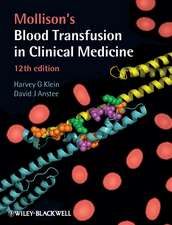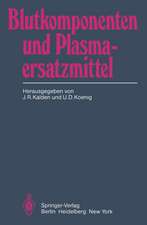Regulation of Haemoglobin Synthesis
Autor J. Neuwirt, P. Ponkaen Limba Engleză Paperback – 12 oct 2011
| Toate formatele și edițiile | Preț | Express |
|---|---|---|
| Paperback (1) | 710.96 lei 6-8 săpt. | |
| SPRINGER NETHERLANDS – 12 oct 2011 | 710.96 lei 6-8 săpt. | |
| Hardback (1) | 718.65 lei 6-8 săpt. | |
| SPRINGER NETHERLANDS – 31 aug 1977 | 718.65 lei 6-8 săpt. |
Preț: 710.96 lei
Preț vechi: 748.38 lei
-5% Nou
Puncte Express: 1066
Preț estimativ în valută:
136.04€ • 142.42$ • 112.57£
136.04€ • 142.42$ • 112.57£
Carte tipărită la comandă
Livrare economică 05-19 aprilie
Preluare comenzi: 021 569.72.76
Specificații
ISBN-13: 9789401010924
ISBN-10: 9401010927
Pagini: 208
Ilustrații: IX, 197 p.
Dimensiuni: 155 x 235 x 11 mm
Greutate: 0.3 kg
Ediția:Softcover reprint of the original 1st ed. 1977
Editura: SPRINGER NETHERLANDS
Colecția Springer
Locul publicării:Dordrecht, Netherlands
ISBN-10: 9401010927
Pagini: 208
Ilustrații: IX, 197 p.
Dimensiuni: 155 x 235 x 11 mm
Greutate: 0.3 kg
Ediția:Softcover reprint of the original 1st ed. 1977
Editura: SPRINGER NETHERLANDS
Colecția Springer
Locul publicării:Dordrecht, Netherlands
Public țintă
ResearchCuprins
1. Introduction.- 2. Substrate Supply for Haemoglobin Syntheses.- Iron Uptake.- Mechanism of iron supply to erythroid cells.- Factors influencing iron uptake by erythroid cells.- Iron and transferrin levels and transferrin saturation.- Metabolic state of crythroid cells.- The role of sulfhydryl groups in iron uptake.- Other factors which influence iron uptake.- Iron uptake from chelating agents.- Intracellular kinetics of iron.- Ferritin.- Other non-haem iron proteins and iron complexes.- Mitochondrial iron.- Inhibitors of haem synthesis as a tool in investigations of the intracellular kinetics of iron.- Regulation of iron supply for haemoglobin synthesis.- Effect of haem on iron uptake by reticulocytes.- Effort of inhibitors of haem and globin syntheses on iron uptake.- Mechanism of the effcct of haem on iron uptake.- Regulation of Uptake of Glycine and other Amino Acids.- 3. Haem Synthesis.- Biosynthesis of Haem.- General introduction.- ALA synthesis.- ALA synthetase.- Porphobilinogen (PBG) synthesis. ALA dehydrase enzyme.- Conversion of porphobilinogen (PBG) to uroporphyrinogen III.- Conversion of uroporphyrinogen to coproporphyrinogen by the enzyme uroporphyrinogen decarboxylase.- Conversion of coproporphynnogen lo protoporphyrinogen by the enzyme coproporphyrinogen oxidase.- Combination of iron with protoporphyrin.- Free protoporphyrin.- Regulation of Haem Biosynthesis.- Enzyme synthesis.- Changes in enzyme activity.- Regulation by substrate supply.- Metabolic and external factors.- Haem catabolism.- 4. Globin Synthesis.- Globin Biosynthesis.- General introduction.- Role of ribonucleic acids in globin synthesis.- Messenger RNA.- Isolation and identification of globin mRNA.- Methods used for the isolation of globin mRNA.- Detection of messenger RNA for globin.- Characteristics of globin mRNA.- Biosynthesis of globin mRNA.- Transfer RNA.- Ribosomes and globin synthesis.- Ribosome structure.- The role of polyribosomes.- The role of sub-units.- Membrane-bound ribosomes.- Function of the active ribosomal complex.- Initiation of the globin chain.- Initiation of globin synthesis by means of methionyl-tRNA.- Initiation factors of reticulocyte ribosomes.- Elongation of the globin chain.- Globin chain termination.- Regulation of Globin Synthesis.- Post-transcription control of globin synthesis.- Stability of globin mRNA.- Translation control.- Rate limiting step in the synthesis of the globin chain.- Synchronization of synthesis of different chains.- The role of haem in globin synthesis.- 5. Regulation of Haemoglobin Synthesis.- Coordination of Haem and Globin Syntheses.- Regulatory role of haem.- Mutual relations between haem and globin synthesis.- Haemoglobin Synthesis During Maturation.- 6. Differentiation of Erythroid Cells.- Erythroid Differentiation in Haematopoietic Tissue and the Initiation of Haemoglobin Synthesis.- Mechamun of erythropoietin action.- Erythroid Differentiation Without Erythropoietin.- 7. Anaemias Due to Disorders of Haemoglobinization.- Hypochromic Anaemias Due to Impaired Haem Synthesis.- Hypochromic anaemias caused by a reduced iron supply into erythroid tissue.- Iron deficiency anaemia.- Congenital atransferrinaemia.- Hypochromic anaemia as a result of reduced iron release from reticuloendothelial cells.- Copper defficiency.- Sideroblastic anaemias.- Hypochromic Anaemias Due to Impaired Globin Synthesis.- Thalassaemia.- ?-thalassaemia.- Haemoglobin Constant Spring and related mutants of the terminal portion of the chain.- ß- and ?ß-thalassaemia.- References.










